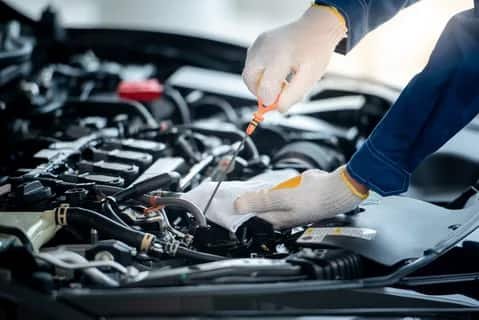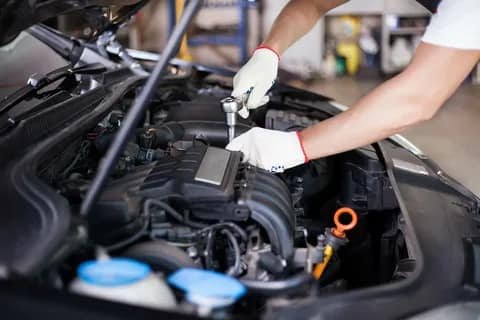At Meta Mechanics, we are committed to providing the highest level of automotive repair and maintenance for luxury vehicles, including the iconic Range Rover Autobiography. Our recent transfer case fluid change job on a Range Rover Autobiography in Dubai involved not only the fluid change but also a detailed inspection of the vehicle’s drivetrain system. Through our expert analysis, we identified several critical issues that required attention. This post will walk you through the process, the problems we encountered, and the solutions we provided.
If you’ve been searching for a car garage near me, car service near me, or Range Rover workshop near me, Meta Mechanics is your trusted partner for all your luxury car repair needs. Our team of certified technicians is always ready to help restore your Range Rover to its optimal performance.
What is the Transfer Case, and Why is Fluid Maintenance Important?
The transfer case in a Range Rover Autobiography is an essential component of the drivetrain system, responsible for distributing power from the engine to both the front and rear axles. In four-wheel-drive and all-wheel-drive vehicles like the Range Rover, the transfer case plays a crucial role in engaging and disengaging the drive system as needed, ensuring smooth performance on different terrains, whether you’re driving on highways, desert sands, or rocky trails.
One of the most critical maintenance tasks for the transfer case is the fluid change. Over time, the transfer case fluid can degrade due to heat, pressure, and contamination from metal shavings. This can lead to a variety of issues, including poor performance, overheating, or even complete failure of the transfer case. Regular fluid changes are essential to ensure the transfer case operates smoothly and efficiently.
Symptoms of Transfer Case Fluid Problems in the Range Rover Autobiography
Before diving into the specifics of the transfer case fluid change, let’s take a look at some signs that indicate your Range Rover Autobiography may need a fluid change or have other underlying issues with the transfer case:
- Whining or Grinding Noises If you start hearing whining, grinding, or clunking noises when driving, particularly when engaging four-wheel drive, it could indicate low or degraded fluid levels in the transfer case. This can result in increased friction and wear on the internal components.
- Difficulty Shifting Between Gears Another sign of transfer case problems is difficulty shifting between two-wheel drive and four-wheel drive. If your vehicle struggles to engage or disengage the transfer case, it may be due to fluid contamination or low fluid levels.
- Fluid Leaks Leaking fluid around the transfer case area is a common sign of wear on seals or gaskets. Low fluid levels can cause inadequate lubrication, leading to overheating and internal damage.
- Slipping or Jerking Movements If your Range Rover Autobiography starts jerking or slipping when accelerating or decelerating, it may be due to fluid contamination or mechanical issues within the transfer case.
- Warning Lights Modern vehicles like the Range Rover are equipped with sensors that monitor various components, including the transfer case. A check engine light or specific transfer case warning light could indicate that the fluid levels are low or that the transfer case is malfunctioning.
If you notice any of these symptoms, it’s essential to address them promptly by contacting a professional car service provider like Meta Mechanics. We specialize in diagnosing and repairing luxury vehicles, including Range Rover Autobiography models.
The Process: Transfer Case Fluid Change at Meta Mechanics
When our team at Meta Mechanics was tasked with performing a transfer case fluid change for a Range Rover Autobiography in Dubai, we took the following steps to ensure the vehicle was thoroughly serviced:
Step 1: Diagnostic Inspection
Before changing the fluid, we performed a thorough diagnostic inspection of the vehicle’s transfer case. Using advanced diagnostic equipment, we assessed the condition of the fluid and checked for any signs of contamination or wear. This step helps us identify any underlying issues, such as leaks, damaged seals, or mechanical damage.
Step 2: Draining the Old Fluid
Once the vehicle was raised and secured, we proceeded to drain the old transfer case fluid. Over time, the fluid can become contaminated with metal shavings, dirt, or debris from the internal components of the transfer case. Draining the fluid properly ensures that the transfer case is free of any harmful contaminants that may cause damage to the internal gears.
Step 3: Inspecting the Fluid for Contamination
We closely examined the drained fluid to look for any signs of contamination, such as metal shavings or discoloration. In this particular case, we found that the fluid had become very dark and gritty, indicating that the transfer case had been under strain for some time. This was a clear sign that the fluid had not been changed for a while and that the transfer case may have been operating under less-than-optimal conditions.
Step 4: Replacing Worn-Out Seals and Gaskets
During our inspection, we identified some worn-out seals and gaskets around the transfer case. These seals were allowing fluid to leak slowly, which contributed to the poor condition of the old fluid. To prevent future leaks and ensure the integrity of the transfer case, we replaced all the necessary seals and gaskets during the service.
Step 5: Refilling the Transfer Case with Fresh Fluid
After addressing the seals and ensuring the transfer case was clear of contaminants, we refilled the transfer case with high-quality, OEM (Original Equipment Manufacturer) fluid. Using the correct fluid ensures that the transfer case is properly lubricated and operates smoothly. It’s essential to use the correct fluid type to avoid issues such as overheating or reduced performance.
Step 6: Testing the Vehicle
Once the new fluid was added, we conducted a test to ensure the transfer case was functioning properly. We engaged the four-wheel drive and checked for any unusual noises or issues. We also inspected the area for any leaks to ensure that the seals were properly installed.
After the test, the Range Rover Autobiography was running smoothly with no signs of abnormal sounds or issues when switching between two-wheel and four-wheel drive.
Additional Issues Found During the Service
While performing the transfer case fluid change, our team noticed a few additional issues that required attention to maintain the vehicle’s overall performance:
- Worn-Out U-Joints: The U-joints that connect the transfer case to the driveshafts were showing signs of wear. Replacing these components will ensure smoother operation and prevent premature wear on the drivetrain.
- Damaged Mounting Brackets: Some of the mounting brackets around the transfer case had become loose, which could lead to vibrations or misalignment. We tightened and reinforced these brackets to prevent further issues.
- Low Differential Fluid: While inspecting the drivetrain, we also found that the differential fluid was low and needed to be topped off. We recommended a differential fluid change as a precautionary measure to keep the entire drivetrain in optimal condition.
Why Choose Meta Mechanics for Your Range Rover Autobiography Repair?
If you’re looking for a Range Rover workshop near me, car garage near me, or car service near me, Meta Mechanics is your go-to car service provider in Dubai. Here’s why:
- Expert Technicians: Our team is highly trained in repairing and maintaining luxury vehicles like the Range Rover Autobiography. We understand the intricate systems that make these vehicles unique and provide high-quality repairs.
- Comprehensive Services: Whether it’s a transfer case fluid change, gearbox repair, or any other complex issue, we offer a full range of services to keep your Range Rover running at its best.
- High-Quality Parts: We use only OEM parts to ensure your Range Rover performs like new. Our transfer case fluid change and other repairs are done with precision and care.
- Customer Satisfaction: We prioritize your satisfaction, and our transparent approach ensures that you’re fully informed about your vehicle’s condition. We aim to deliver high-quality repairs in a timely manner.
- State-of-the-Art Diagnostic Tools: At Meta Mechanics, we use the latest diagnostic equipment to ensure accurate results and effective repairs. Our state-of-the-art tools help us quickly identify problems and provide the best solutions.
Conclusion
Regular transfer case fluid changes are vital for maintaining the performance of your Range Rover Autobiography. At Meta Mechanics, we are dedicated to providing expert Range Rover repair services in Dubai. If you notice symptoms like grinding noises, fluid leaks, or difficulty engaging four-wheel drive, don’t wait for the issue to escalate – contact us today for a thorough inspection and top-quality Range Rover repairs.
Looking for a Range Rover workshop near me or a car garage near me? Meta Mechanics has got you covered. Our expert team is here to ensure your Range Rover Autobiography stays in peak condition for years to come. Reach out to us today to schedule your transfer case fluid change and other maintenance needs!
Range Rover Autobiography Fluid Level Check
- Inspecting the current fluid level in the transfer case to determine if a fluid change is necessary due to low levels.
Range Rover Autobiography Fluid Drainage
- Draining the old, contaminated fluid from the transfer case to prevent the buildup of dirt or particles that affect performance.
Range Rover Autobiography Fluid Filter Replacement
- Replacing the fluid filter within the transfer case to prevent debris from circulating and damaging the internal components.
Range Rover Autobiography New Fluid Filling
- Refilling the transfer case with fresh, manufacturer-recommended fluid to ensure proper lubrication and smooth function of gears and components.
Range Rover Autobiography Seal and Gasket Inspection
- Inspecting and replacing seals or gaskets to prevent leaks during the fluid change process, ensuring proper fluid retention.
Range Rover Autobiography Transfer Case Fluid Flushing
- Performing a flush to remove old, degraded fluid and debris, restoring the performance and efficiency of the transfer case system.
Range Rover Autobiography Fluid Compatibility Check
- Ensuring the correct type of transfer case fluid is used, which is compatible with the vehicle’s make and model specifications.
Range Rover Autobiography Transfer Case Seal Check
- Checking for any signs of wear on the transfer case seals to prevent future fluid leaks after the fluid change.
Range Rover Autobiography Fluid Quality Test
- Testing the condition of the fluid to determine if it has degraded, which helps identify the need for fluid replacement.
Range Rover Autobiography Test Drive After Fluid Change
- Performing a test drive to ensure the transfer case operates smoothly with the new fluid, checking for any unusual noises or performance issues.



